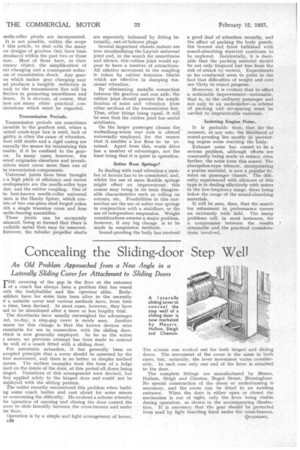Concealing the Sliding-door Step Well
Page 88

If you've noticed an error in this article please click here to report it so we can fix it.
An Old Problem Approached from a New Angle in a Laterally Sliding Cover for Attachment to Sliding Doors rHE covering of the gap in the floor at the entrance
of a coach has always been a problem that has vexed path the bodybuilder and the operator alike. Bodymilders have for some time been alive to the necessity if a suitable cover and various methods have, from time o time, been devised. In most cases, however, they have tad to be abandoned after a more or less lengthy trial.
The drawbacks have usually outweighed the advantages .nd, to-day, a step-gap cover is rarely seen. Another eason for this change is that the known devices were insuitable for use in connection with the sliding door, vhich is now generally employed. So far as the writer s aware, no previous attempt has been made to conceal he well of a coach fitted with a sliding door.
For automatic actuation, it has generally been an ccepted principle that a cover should be operated by the loor movement, and there is no better or simpler method mown. The earliest examples took the form of a ledge ixed on the inside of the door, at this period all doors being iinged. Variations of this arrangement were devised, but hey applied solely to the hinged door and could not be ,rnployed with the sliding pattern.
The writer recently encountered this problem when buildng some coach bodies and cast about for some means or overcoming the difficulty. He evolved a scheme whereby he operation of opening and closing the door caused the over to slide laterally between the cross-bearers and under he floor.
Operation is by a simple and light arrangement of levers. ca8 The scheme was work...‘d out for both hinged and sliding doors. The movement of the cover is the same in both cases, but, naturally, the lever movement varies considerably. In each case only one end of the lever is attached to the door.
The complete fittings are manufactured by Messrs. Hallam, Sleigh and Cheston, Bagot Street, Birmingham. No special construction of the doors or underframing is necessary, and the cover can be fitted to an existing entrance. When the door is either open or closed the mechanism is out of sight, only the lever being visible during operation, as shown in the accompanying illustration. It is necessary that the gear should be protected from mud by light boarding fixed under the cross-bearers.




























































































































































